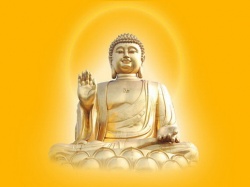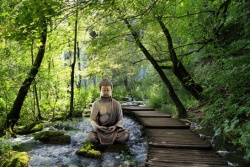5-Aggregates
See Aggregates.
5-Aggregates are also known as 5-Resultant Aggregates as they are the result of past existences. As the functions, like, bathing. dressing, eating, etc. are performed, no results are produced for the future existences. One may experience bodily Suffering, but in the case of an Arahat, he has no mental Suffering, like worry, anxiety, Grief, etc., which cause future existences. It is unwise reflection or recollection (ayoniso Manasikāra) on the 5-Aggregates that bring forth the 5- Clinging or Grasping Aggregates. The 5-Aggregates are subjective whereas the 5-Clinging Aggregates are objective, being objects of Clinging." This will be clearer as we proceed.
The 5-Resultant Aggregates arise from Consciousness, Mentality-Materiality, 6 bases, Contact and Feeling. The 5-Clinging Aggregates arise when there are Ignorance, Formations, Craving, Clinging, and Becoming. They cause the 5-Clinging Aggregates, as and when they are made to arise, by unwise thinking, attention, reflection, planning, recollections. It is due to clinging that the 5-Clinging Aggregates and the corruptions arise. For example, the Mind takes the subjective person as the object of reflection, and remarks are made such as, "What a clever man I am," "I am handsome." There is clinging to the person (materiality & mentality) as "I" at those times.
It is something more than the normal or ordinary workings of the mind. It is extra workings of the Mind. The clinging is accompanied by the corruption of conceit. When the Mind takes the son, for example, as the object of reflection and there is anxiety as to whether he will pass the examination or make good in Life, there is clinging to the son as "’mine" and the corruptions of anxiety or worry arises. These mental actions of reflection, recollection, etc., result in likes, dislikes, fear, worry, anxiety and other corruptions.
The mind is disquieted, distressed, disturbed, and we will learn later that this is Suffering. In the Sutta-Nikāyas, called Kindred Sayings, dealing with Khandha, in one of the Discourses, it is said that the 5-Khandhas become Upādāna Khandhas when there are āsavas. āsavas have been translated as Intoxicants, Cankers, Biases.
There are 4 kinds of āsavas, namely.
1. Kāma-āsava,
2. Bhava-āsava,
3. Ditthi-āsava,
4. Avijjā-āsava.
1. Kāma-āsava is the Intoxicant of Sensuality, the sensual desire, sensual passion, sensual delight,sensual Craving, sensual fondness, sensual thirst, sensual fever, sensual rapacity, which is the result of the pleasures of the senses.
2. Bhava-āsava is the Intoxicant of Renewed Existence, the desire, the passion for coming into being, delight in coming into being, Craving, fondness for coming into being, the fever, the yearning, the hungering to come into being, which is felt concerning rebirths.
3. Ditthi-āsava is the Intoxicant of speculative opinion, or wrong views. You don’t know you have a wrong view. You have a Craving for your view. You think that whatever you do is right. You think, "I know". The tanhā or Craving here is based on Love of yourself.
4. Avijjā-āsava is the Intoxicant of Ignorance, of Ignorance of the 4-Noble Truths. You do not know correctly. You have built a monastery and you are looked up to and you Love it; it is a Form of tanhā. Avijjā exists always along with tanhā. Avijjā is the cause and tanhā is the effect.
So there is always a streak of tanhā in all the differing forms of āsava.
Tanhā, Māna, Ditthi, this is the order in which the Pāli expressions are usually known, but it is the last which is eradicated first.
It means that there are 3 Forms or Aspects of Self in Buddhism
1. Tanhā (Possessive) Self.
2. Māna (Conceit) Self.
3. Ditthi (Wrong View) Self
All the time, the worldling is running after different objects of sense and the mind-sense. There is seeing, and hearing, and tasting, etc. There arises the idea of "I see", "I hear", "I taste", etc. There is really no "I", but the Mind-Consciousness has bluffed the World-ling by injecting the idea of "I". As Ditthi has to be eradicated first, before one becomes a Sotāpanna, let us deal with it first. It is Wrong View or Wrong belief. When you meet a person, how do you recognise him, or distinguish him from others? By his exterior Form, by his exterior Body. Others recognise you similarly. We know that only ultimates are realities and all the rest are conventional concepts and terms.
If this Form or Body is taken as "I" or Self, it is wrong view regarding what is not an ultimate reality, and such a wrong view is called micca-Ditthi. Sakkāya-ditthi is wrong view regarding an ultimate, constituent of oneself. We cannot see an ultimate with the naked eye, but know it with the inner eye. Take, for instance, the ultimates behind the 5- Aggregates which are composites and therefore conventional terms. These ultimates may be rightly viewed by you as mere ultimates, but if you wrongly view these ultimates as self, it is Sakkāya-ditthi. The human Body exists. This statement is on a par with the statement that water exists. It is a conventional term; it is paññatti.
Water is not an ultimate reality and the human Body is not an ultimate reality. The human Body is composed of atoms and cells. The Buddha was at pains to point out that the human Body is not an ultimate and that there are 32 constituent parts of the Body, so that the worlding will know that a human Body was a composite, just as a "chariot" was a composite. And again, none of the 32 constituent parts is an ultimate. The human being is not "I" or mine. It is a perversion of thinking that the human Body is "I" or mine or Myself. The "I" is a mental concept. There is no physical basis for the concept of "I". It is also a perversion. We know that the mental part or Nāma consists of the 4 Mental Aggregates, namely Viññāna, vedanā, saññā and Sankhāra. Where is the "I"? It is the work of Mind-Consciousness, the Big Magician to inject the idea of an "I". It’s just a perversion.
The Buddha asks us not to be bluffed by the Big Magician. Life consists of natural processes that function by themselves and we should not put an attā (Self) to it. We have been stressing the fact that it is not my "I", but that it is the Mind that is the controller of everything. The Mind motivates everything. The Buddha’s Teaching is the Middle Way. It says that Eternity Belief and Annihilation Belief are wrong. Eternity Belief (sassatha Ditthi) is the existence of a persisting Ego-Entity or Individuality existing independently of physical and mental processes that constitutes Life, and continuing ever after Death. Annihilation Belief is the belief in the existence of an Ego-Entity or Personality which is annihilated at Death. The Buddha, however, teaches that the Personality or Ego is but a conventional designation (vohārasacca), whilst in the ultimate sense (Paramattha-Sacca) there is only this consuming process of physical and mental phenomena which continually arise and disappear immediately.
The Buddha has dissected the Body and Mind into its constituent parts, namely the 5-Aggregates, i.e., the Matter Aggregate, and the Mind having four Aggregates, namely, Viññāna, vedanā, saññā and Sankhāra, and nothing more. There is no soul whatever. The Conceit Self is eradicated only when one becomes an Arahat. Conceit is of many kinds and forms and some are enumerated thus: conceit of accomplishment, of appearance, of bearing, of birth, of bodily perfection, of bodily proportion, being not despised, of dexterity, erudition, gain, having adherents, health, being honoured, intelligence, of kinsmen, being an acknowledged authority, being moral, of prominence, popularity, being respected, tall, Wealth, youth, etc. Also the ideas "I am better", "I am equal". The tanhā or Possessive or Craving Self is similarly eradicated only on becoming an Arahat. Craving is the cause of Suffering, as will be explained in the exposition of the 4-Noble Truths, and Craving is the cause of continuing the cycle of rebirths.
Craving is of 3 Kinds:
1. Craving for sense pleasures (Kāma-tanhā),
2. Craving for existence (Bhava-tanhā)
3. Craving for self-annihilition (vibhava-tanhā).
Craving is of many forms, and is very cunning. There is Craving when there does not seem to be any that is apparent. It is quite a job to drive out this Craving. Practically the most important Teaching of The Buddha is that there is no Self. If you believe in a Self you will act in one way, but if you believe there is no Self, you will act in another way. It is with Wisdom that you come to know that there is no Self that there is no attā. The teaching of tanhā, Māna, Ditthi, the Teaching of the 4-Noble Truths of Suffering, the Teaching of Anicca, Dukkha, anattā, in fact the whole of the Abhidhamma is calculated to make you know that there is no Self, that there is no attā, namely, everything is anattā.
Say, you own a piece of of land. If you think that you will find petroleum or gems in your land, you will dig. If you have not found it yet, on your deathbed, you will ask your children to go on digging. But if you are sure in your lifetime that there is no petroleum or gems in your land, you will not follow the useless task of digging your land. Similarly, if you are sure that there is no attā or self within your Body, you will avoid certain acts which you are sure is a waste of time.
See; The five aggregates


